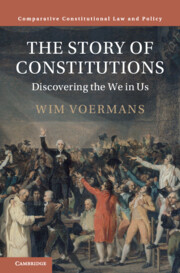Book contents
- The Story of Constitutions
- Comparative Constitutional Law and Policy
- The Story of Constitutions
- Copyright page
- Dedication
- Epigraph
- Contents
- Figures
- Prologue
- 1 Introduction
- Part I Constitutional Diffusion
- Part II The History of the Constitution
- Part III Concepts, Shapes and Types of Constitutions
- Part IV Effects
- 20 What Does a Constitution Do?
- 21 The Legal Meaning of Constitutions
- 22 Economic Aspects
- 23 Political Aspects
- Part V The Imagined Order of the Constitution
- References
- Name & Author Index
- Subject Index
22 - Economic Aspects
from Part IV - Effects
Published online by Cambridge University Press: 19 October 2023
- The Story of Constitutions
- Comparative Constitutional Law and Policy
- The Story of Constitutions
- Copyright page
- Dedication
- Epigraph
- Contents
- Figures
- Prologue
- 1 Introduction
- Part I Constitutional Diffusion
- Part II The History of the Constitution
- Part III Concepts, Shapes and Types of Constitutions
- Part IV Effects
- 20 What Does a Constitution Do?
- 21 The Legal Meaning of Constitutions
- 22 Economic Aspects
- 23 Political Aspects
- Part V The Imagined Order of the Constitution
- References
- Name & Author Index
- Subject Index
Summary
In this chapter economic aspects of constitutions are explored. Basically there are three. Constitutions, firstly, act as a condition for markets and the overall economy: they are, most of the time, criticial preconditions for economic development by the - predictable - laws they generate and the protection they offer for property and capital). Secondly constitutions act as a factor in markets and the economy. They, for instance, lower transaction costs. And. thirdly, constitutions act as a catalyst in economic relations, e.g. by boosting mutual trust.
Keywords
- Type
- Chapter
- Information
- The Story of ConstitutionsDiscovering the We in Us, pp. 258 - 269Publisher: Cambridge University PressPrint publication year: 2023

